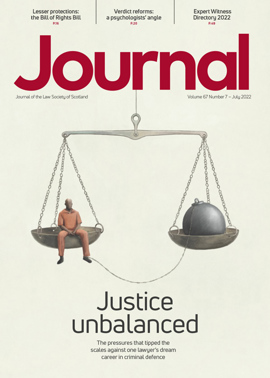Opinion: Elaine Farquharson-Black
 The recent Scotland’s Urban AGE 2022 (“SUA2”) report – a major academic study on the future of Aberdeen, Glasgow and Edinburgh (“AGE”) and their respective city regions – has highlighted the need for innovation, investment and informed leadership to address the shocks which Scotland’s urban system faces in light of the combined challenges of climate emergency, COVID-19, Brexit, the war in Ukraine and the financial crisis.
The recent Scotland’s Urban AGE 2022 (“SUA2”) report – a major academic study on the future of Aberdeen, Glasgow and Edinburgh (“AGE”) and their respective city regions – has highlighted the need for innovation, investment and informed leadership to address the shocks which Scotland’s urban system faces in light of the combined challenges of climate emergency, COVID-19, Brexit, the war in Ukraine and the financial crisis.
Commissioned by the Aberdeen, Glasgow and Edinburgh Chambers of Commerce and supported by Brodies and AAB, the report found that the centripetal position of the AGE cities means that they have been hit hardest by the pandemic, which hollowed out shared spaces, devastated high streets and accelerated societal change.
Given their concentrations of population, wealth and knowledge, SUA2 stresses that the success of the three cities is a litmus test of Scotland’s future. As such, the report makes several recommendations based on the key themes of developing our human capital, climate leadership, city centre regeneration, flexibility within planning frameworks and the reshaping of business rates.
The overriding message from the authors is that our cities need to be dynamic to avoid decline. They need to be empowered to respond to local needs and opportunities. Funding will be key in that regard, and the report recommends that devolving meaningful tax raising and other fiscal powers to our cities would allow for the delivery of programmes that reflect those local needs. That, of course, is a matter for policymakers, but it is clear that change needs to happen, and happen fast.
The report advocates not only a design-led approach to regenerating the AGE cities but also a systems and service design approach based on the quality of people’s lives and their places. It suggests various scenarios for the potential futures of the business sector, the retail industry, cultural venues, the transportation system, and office property market (all of which are changing at the same time), to help understand the threats and opportunities which we face in finding new, more creative ways to make our cities safe, just and sustainable spaces.
SUA2 highlights that the cities face greater challenges than previously, due to the flux in all market sectors in terms of societal need, location, use and design. It calls for a more flexible, agile and responsive planning function, to support greater and faster change. Policy, economic development and design must work together to decarbonise the built environment and create a new vibrancy within each of the AGE cities. This will require retrofitting on an unprecedented scale.
One way of doing that lies in reimagining the office. At Brodies, we are already seeing demand for quality buildings that satisfy the requirements of larger occupiers. That includes more flexible space, more collaboration space and strong ESG credentials – all designed to encourage people back into the office and into the office community – something that simply can’t be replicated at home.
With office space, it will be a case of evolution, not revolution. For example, Glasgow simply doesn’t have enough available grade A office supply for even one year’s worth of takeup. As a result, the city is going to see a raft of refurbishments coming down the line.
But this has to be matched with the decarbonisation and deep retrofit of the older office buildings within Glasgow city to meet these occupational needs – for which, as SUA2 highlights, political will and fiscal impetus are required to facilitate that repurposing and redevelopment.
And in retail, the recently opened St James Quarter in Edinburgh has got off to an encouraging start, attracting new entrants to the Scottish retail market, as well as relocating occupiers from other parts of the city centre.
With vision and collaboration, Edinburgh’s previous retail showcase, Princes Street, has huge development potential.
A move to a more experiential economy, with flagship stores interspersed with hotel, leisure and residential offerings, could see it reinvigorated to be on a par with the likes of the Champs Élysées in Paris or Regent Street in London.
Aberdeen presents its own opportunities, and is identified in SUA2 as a unique case by dint of its role as Scotland and the UK’s oil capital and, going forward, as a carbon-neutral pioneer. While the loss of major office buildings and national retailers has had a palpable effect on the city centre, this can also provide added impetus for investment and diversification, including enhanced opportunities to increase city centre living, with new models such as build to rent.
Cities excel at bringing people together, and SUA2 provides a framework for how we can, and indeed must, work in partnership to ensure the economic recovery and ongoing success of the AGE cities.
Change is often difficult, but it is easier if we are all working toward a common goal of making our cities better. Working together: now, wouldn’t that be a shock to the system?
Perspectives
Features
Briefings
- Civil court: Issues on appeal
- Licensing: Minimum pricing – a genuine impact?
- Insolvency: How to admit joint creditor claims
- Tax: windfall and plastic packaging taxes raise stakes
- Immigration: Asylum system overhauled
- Scottish Solicitors' Discipline Tribunal: July 2022
- In-house: In with the stonework
- Property: Living with the Register of Overseas Entities
In practice
- OPG update: July 2022
- Public policy highlights: July 2022
- Gear up for the Scottish Legal Walks
- Disabled solicitor support group proposed
- Risk: Cybercrime – the hybrid worker prey
- Ask Ash: Piling it on
- TRS: time for a trusts trawl
- Know people, know business
- High street and hybrid
- Appreciation: Ian Leslie Shaw Balfour
- The Expert Witness Directory 2022
- Expert witness: case law update







